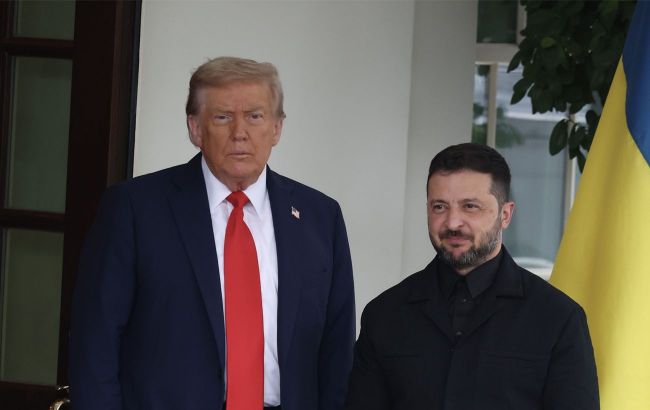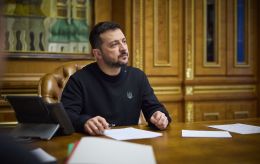Trump's ultimatum to Kyiv: What Washington expects and how Ukraine and Europe reacting
 Photo: Volodymyr Zelenskyy and Donald Trump (x.com/ZelenskyyUa/)
Photo: Volodymyr Zelenskyy and Donald Trump (x.com/ZelenskyyUa/)
The United States has taken up the promotion of Donald Trump’s new peace plan with extraordinary zeal — a plan whose core points are largely unacceptable for Ukraine.
RBC-Ukraine explains the essence of the document and the reactions from Ukraine and Europe.
Key questions:
-
What ultimatum has the United States delivered to Ukraine?
-
What are Kyiv, Washington, and Brussels saying?
-
What negotiating space does Ukraine still have?
Just a month ago, it seemed that all US President Donald Trump's peace initiatives had fizzled out, and any new negotiations could be forgotten at least until spring. Ukraine was therefore preparing for a difficult winter with energy problems and new Russian attacks, which were later compounded by the “Mindich-gate” scandal.
But the silence turned out to be deceptive. This week, several American media outlets reported that the White House had prepared a new, ambitious, and very detailed plan of 28 points. On November 20, an American delegation led by US Secretary of the Army Daniel Driscoll presented it to Ukrainian President Volodymyr Zelenskyy. Kyiv took the plan under review, though without enthusiasm.
“Ukraine may face a very difficult choice: either the loss of dignity or the risk of losing a key partner. Either the difficult 28 points or an extremely hard winter — the hardest — and further risks," Zelenskyy said in an address to Ukrainians.
What the plan includes
The proposals published by several American outlets were developed by the US and Russia without Ukraine’s real involvement. Moreover, as The Guardian notes, some phrases in the plan were likely originally written in Russian, as certain formulations are not typical of English. Unsurprisingly, the plan contains a set of significant concessions expected from Kyiv.
RBC-Ukraine has already detailed them. Among the main demands for Ukraine are:
-
recognition of Crimea, Donetsk, and Luhansk regions as part of the Russian Federation, with the withdrawal of Ukrainian forces from controlled areas of these regions;
-
freezing the line of contact in Kherson and Zaporizhzhia regions;
-
limiting the Ukrainian army to 600,000 personnel;
-
establishing a neutral status that rules out NATO membership.
The plan also includes confirmation of Ukraine’s non-nuclear status and IAEA control over the Zaporizhzhia Nuclear Power Plant, with electricity distribution divided equally.
Russian concessions, with great stretch, may include a hypothetical withdrawal from Kharkiv, Sumy, and Dnipropetrovsk regions. This is not directly stated in the leaks but implied by their content. According to Axios, the plan includes 10-year security guarantees for Ukraine resembling NATO’s Article 5, and permits US military action in the event of another attack on Ukraine. Russia must also enshrine in its constitution a policy of non-aggression toward Ukraine and Europe.
The proposals further envision investments in Ukraine’s reconstruction, removing Russia from international isolation by lifting sanctions, unfreezing Russian assets, granting amnesty to all participants in the war, and holding elections in Ukraine 100 days after signing an agreement.
White House press secretary Karoline Leavitt said the plan was developed "to reflect the realities of the situation" to "find the best win-win scenario, where both parties gain more than they must give."
However, a senior American official told RBC-Ukraine that some messaging in the media about the plan is unfounded, without specifying which parts. He added that Trump’s main message is that achieving peace will require concessions from both Ukraine and Russia.
Negotiating space
The President’s Office said that Ukraine is ready for constructive cooperation with the US, EU partners, and the international community to achieve peace.
"In the coming days, the President of Ukraine expects to discuss with President Trump the existing diplomatic opportunities and the key points required to achieve peace," the Office said.
Some details of the plan were already discussed on November 20 with the same American delegation led by Driscoll.
In his address, Zelenskyy said Ukraine will propose alternatives.
"The national interest of Ukraine must be taken into account. We are not making loud statements. We will work calmly with the US and all partners," Zelenskyy emphasized.
In the end, several points of the plan will likely require amendments to Ukraine’s Constitution — such as neutral status — which may become an additional argument for Kyiv during talks.
"Ukraine needs to present its arguments and examples. How to amend the Constitution. For this, you must first lift martial law, hold elections, and under Ukrainian law, these changes must be spaced out in time. If elections take place, will there be enough votes to amend the Constitution?" said Oleksandr Leonov, executive director of the Penta Center for Applied Political Studies, in a comment to RBC-Ukraine.
Europe’s position is also important. Although, according to the Financial Times and other outlets, Europeans were not involved in drafting the plan, they will play a crucial role in the economic aspects of any potential agreement.
"For example, if Europe refuses to unfreeze Russian assets — especially under the conditions spelled out there — then Donald Trump’s economic interest decreases. Europe holds roughly €250–270 billion of the €300 billion in frozen Russian assets, while the US holds only about €5 billion. How will Trump manage funds he cannot access and has no authority over — that’s a big question," Leonov emphasized.
The EU has already expressed dissatisfaction. The Wall Street Journal reports that EU leaders privately call Trump’s plan a "capitulation of Ukraine" and intend to use their contacts in the White House to dissuade the US president. Europe also hopes to prepare its own plan within days, with more favorable terms for Kyiv.
However, after speaking with European leaders, Zelenskyy said work is ongoing, specifically on the document prepared by the American side.
"We coordinated the next steps and agreed that our teams will work together at the corresponding levels," Zelenskyy said.
US pressure
Trump’s team insists that agreements must be reached as quickly as possible. According to CNN, Trump wants Ukraine and Russia to sign a peace deal by the end of the year. A Reuters source said that, at the White House’s insistence, Ukraine must sign a framework agreement by next Thursday — otherwise the US has threatened to halt arms supplies and intelligence sharing.
A senior US official explained this position to RBC-Ukraine: "If you’ve been watching President Trump, you should feel that when it comes to an aggressive timeline, it means tight deadlines on his terms. It means right now, it means as soon as possible," he said.
The US indeed has leverage over Ukraine. Currently, the key aid Kyiv receives from Washington is intelligence, noted senior analyst Anton Zemlyanyi of the Ukrainian Center for Security and Cooperation.
He noted that regarding the PURL program (European-funded purchases of American weapons), it could theoretically be suspended, but the ones who would suffer the most would be American arms manufacturers, the US economy, and Trump’s personal approval ratings.
President Zelenskyy has already spoken with US Vice President JD Vance — and these contacts will not end there. According to several RBC-Ukraine sources in government, the current escalation of Trump’s peacemaking efforts may be the most intense yet.

